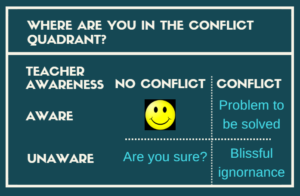Conflict in the diverse adult classroom
Discussion of conflict resolution often starts with describing the conflict. But are you confident that you can even identify when there is conflict in your classroom?  When you add intercultural communication to the mix, your usual indicators of conflict may fail you. What makes you aware there is conflict? Questions from your students such as
When you add intercultural communication to the mix, your usual indicators of conflict may fail you. What makes you aware there is conflict? Questions from your students such as
Why do we have to do this?
Why do we have to do it this way?
Why are you treating so and so in this way?
- Non-cooperation
- Raised voices
- Rarely, there may be physical fighting.
- Evasive response
- Silence
- Non-response
- Smiling
The ideal place in the quadrant is top left where there is no conflict and you are certain about that. Being in the top right quadrant may not be comfortable but at least you know you have a problem. Being in the bottom right quadrant would be very bad, as undiagnosed conflict will mean that the potential of your class will not be as high as it could be. The bottom left quadrant is a good place to be, but can you be certain that there is no conflict and will you be aware if you drift into one of the right hand quadrants? Can you identify any specific times when you realised that you were in any one of these four quadrants?